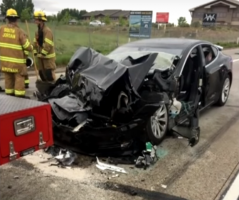— A Utah Tesla Model S owner claims in a lawsuit that Tesla should pay more than $300,000 because the woman broke her foot/ankle when the car crashed because she was looking at her phone.
Heather P. Lommatzsch says she purchased the 2016 Model S in July 2016 and within a year a company called Service King replaced a sensor on the car.
The lawsuit doesn't explain why Tesla didn't perform the work on the new car and the plaintiff doesn't say what type of sensor was replaced, although she is suing Service King as part of the Tesla suit.
On May 11, 2018, Lommatzsch was driving southbound on Bangerter Highway in South Jordan City with traffic ahead that had stopped. The Model S had Autopilot engaged when the car slammed into a fire vehicle at 60 mph.
Lommatzsch says when she bought the car she talked to Tesla's sales staff and understood the safety features would ensure the Model S would "stop on its own in the event of an obstacle being present in the path of the Tesla Model S."
The lawsuit alleges the car didn't perform as advertised and even when she hit the brakes they didn't work. The plaintiff also claims Tesla sales people told her she just needed to touch the steering wheel occasionally when Autopilot was engaged.
According to the lawsuit, Tesla was "negligent in developing, designing, manufacturing, producing, testing, promoting, distributing, selling, maintaining, repairing and/or servicing the Tesla Model S, and/or providing adequate warning of the dangers of the Tesla Model S."
The plaintiff also claims she wasn't warned about the proper use of the car and the Autopilot system, but the lawsuit doesn't mention if the driver ever took the time to read the owner's manual.
South Jordan police believe the Model S was on cruise control and following another vehicle at 55 mph, matching the speed of the lead vehicle. Authorities believe the lead vehicle changed lanes, and because the Model S had cruise control engaged, the Tesla increased its preset speed to 60 mph.
However, the car did this without "seeing" the vehicles stopped ahead.
According to the car's data, the driver removed her hands from the steering wheel dozens of times and on two occasions her hands didn't touch the wheel for more than 60 seconds. Her hands allegedly stayed off the steering wheel until she received visual warnings to put her hands back on the wheel, only to quickly remove her hands each time.
Tesla says that 1 minute and 22 seconds before the crash, Lommatzsch re-enabled autosteer and cruise control and within two seconds took her hands off the steering wheel again. This matches with the report she gave police that she was looking at her phone before the crash.
And while the plaintiff says she used the brakes but they didn't work, the car's data indicates she touched the brake pedal fractions of a second prior to the crash.
As for who was responsible for the crash, local police cited Lommatzsch for "failure to keep proper lookout."
Following media reports of the crash, Tesla CEO Elon Musk said, "What’s actually amazing about this accident is that a Model S hit a fire truck at 60 mph and the driver only broke an ankle. An impact at that speed usually results in severe injury or death."
The Tesla Model S Utah crash lawsuit was filed in the Third District Court for the State of Utah, Salt Lake County - Heather P. Lommatzsch v. Tesla, Inc., et al.
The plaintiff is represented by MacArthur, Heder & Metler, PLLC.

